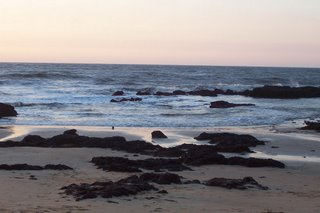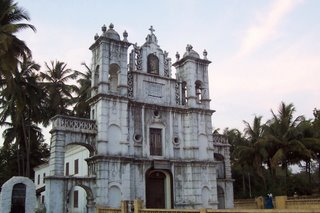
Sunset over Goa
By the time I boarded the night train in Mumbai's Victoria terminal, the busiest train station in Asia, my long campaign against Delhi-belly was almost won and I even managed a good night sleep before arriving in Goa. A rickshaw brought us to Anjuna beach where we began our ritual search for a decent budget room. Along the way, we met up with party-Dean whose presence in the hash-fueled hippy holiday pilgrimage of Goa was entirely predictable. He was nursing a beer at Anjuna's cleanest 30 Rupee eatery while he gave us the low down on the late-night beach side shindigs.
The budget rooms in Goa range from the dank and stinky to the downright scary. As we swung open the creaking doors, an ancient mildewy marijuana haze would issue forth from dark cave-like hovels revealing the blinking startled eyes of crusty backpackers who looked like they hadn't seen the light of day for years. Out of the dark murkiness, an intoxicated voice somewhere deep inside informed us through the cobwebs, "Yeah, man. For only 100 Rupees, this place is a steal !"
Miraculously, we stumbled across a family who, for almost no money at all, rented us a private room in their house, invited us to their dining room table each night for a much appreciated home-cooked Goan meal, and effectively adopted us for a week. Rather than hanging out with Party Dean and Goa's stoned beach bum crowd, we spent much of our days just relaxing on their patio with the mother and playing with her child, while granny was more than happy to fetch us a bucket of hot water when we needed to shower. This was budget travelling at its best !

Our life in Goa revolved around this little man called "Om".
To be frank, the Goan beaches themselves are a bit shocking. They teem with fat topless Germans and the gangs of young Indian men who come just to stare at them, while drunken leathered ex-hippies lament endlessly about how awesome Goa used to be to anyone polite enough to listen to them. Walking down the beach at sunset is done to the throbbing beat of techno emanating from the nearby Western oriented development while constantly vigilant to avoid the unpleasant feeling of slowly sinking your bare feet into the gooey softness of newly deposited dung piles left behind by Goan cows which (god bless them) strut emphatically up and down the coast turning their noses up at the invading European tourist hordes.

And what about Goa as the party place of all-night, open-air raves where the world's young bronzed travellers drink and smoke the night away ? This ended years ago with the enforcement of a government ban on loud music past 10pm at night. It wasn't unusual to find ourselves whiling away the evening at an empty ocean side bar feeling positively lonely as we watched the cows casually stroll by. Meanwhile disappointed party-seeking backpackers were being robbed by the exorbitant cover charge of the only nearby night club that is allowed to be open, or they were negotiating with the beach-side traffickers before holing themselves up again in a dingy budget hermitage.

Anjuna beach feels a bit like an Indian Costa Del Sol with scantily clad Western women being hustled by beach touts and hopeful Indian masseuses.

Relaxed liquor laws makes Goa an affordable spot to kick back on the beach with a beer.

Goa's dusk colors.
To be fair, those that can stomach lying on the beaches all day with a backdrop of all-inclusive package holiday development often love the place. However, it wasn't long before we felt impelled to escape.
Riding a motorcycle through the small villages and back country is a completely different experience guaranteed to re-affirm one's faith in Goa. While occasionally stopping to feast on the outstanding local coconut milk seafood curries and spicy fish creations, we weaved through the back roads between the palm groves, lagoons, and green rice paddies of some of south India's finest scenery.

Images of our Goan back-country motorbike trips.
Britain was neither the first colonial power to arrive in India nor were they the last to leave. Both of these honors go to Portugal who controlled Goa from 1510 until 1961. During its heyday in the 16th century when Portugal had a monopoly over Indian and far-East trade, the majesty and splendor of "Golden Goa" was said to rival Lisbon itself with a population exceeding that of London. However, if it weren't for a couple of impressive cathedrals that survived intact, Katlijn and I would have difficulty believing this now as our motorbike roared past crumbling church remains drowning in the surrounding jungle of palm trees. Without the resources to maintain its overseas empire, Portugal's Indian colony was eventually eclipsed by that of Britain and Old Goa was forgotten.

Atmospheric white-washed churches dot the tropical green landscape. Goa was the most successful of Europe's India colonies at converting the locals: today more than 30% of Goa's population is catholic.
 Aging gracefully with their red-tiled roofs, these old Aging gracefully with their red-tiled roofs, these old
Portuguese houses reminisce over Goa's current capital of Panaji. Panaji is one of our favourite anachronisms in India blending the pastel shades of the Mediterranean with noisy India, it is probably the only place on the sub-continent serving delicious and authentic Portuguese food.
|
















